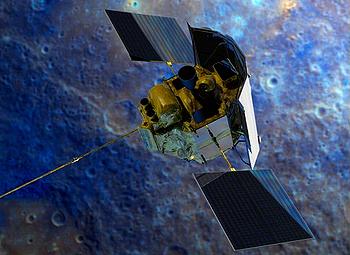
WASHINGTON, DC, May 4, 2015 (ENS) – NASA’s 10-year-long planetary exploration mission to Mercury came to a planned end Thursday when it slammed into Mercury’s surface at about 8,750 miles per hour, creating a new crater on the planet’s surface.
Mission controllers at the Johns Hopkins University Applied Physics Laboratory in Laurel, Maryland confirmed NASA’s MErcury Surface, Space ENvironment, GEochemistry, and Ranging (MESSENGER) spacecraft hit the surface of small, hot planet closest to the Sun, as planned, at 3:26 pm EDT.

“We monitored MESSENGER’s beacon signal for about 20 additional minutes,” said mission operations manager Andy Calloway of APL. “It was strange to think during that time MESSENGER had already impacted, but we could not confirm it immediately due to the vast distance across space between Mercury and Earth.”
The MESSENGER spacecraft is the first ever to orbit the planet Mercury. APL built and operated the spacecraft and managed the mission for NASA’s Science Mission Directorate in Washington.
“Going out with a bang as it impacts the surface of Mercury, we are celebrating MESSENGER as more than a successful mission,” said John Grunsfeld, associate administrator for NASA’s Science Mission Directorate.
In the mission’s more than four years of orbital operations, MESSENGER has acquired over 250,000 images and extensive other data sets.
MESSENGER determined Mercury’s surface composition, revealed its geological history, discovered its internal magnetic field is offset from the planet’s center, and verified its polar deposits are mostly water ice.

“The MESSENGER mission will continue to provide scientists with a bonanza of new results as we begin the next phase of this mission – analyzing the exciting data already in the archives, and unravelling the mysteries of Mercury,” Grunsfeld said.
Just before impact, MESSENGER’s mission design team predicted the spacecraft would pass a few miles over a lava-filled basin on the planet before striking the surface and creating a crater estimated to be 50 feet wide.
MESSENGER’s end was unobserved because the craft hit the side of the planet facing away from Earth, so ground-based telescopes were not able to capture the moment of impact.
Space-based telescopes were unable to view the impact, as Mercury’s proximity to the Sun would damage their optics.
The mood in the Mission Operations Center at APL was both somber and celebratory as team members watched MESSENGER’s telemetry drop out for the last time, after more than four years and 4,105 orbits around Mercury.
MESSENGER was launched on August 3, 2004, and began orbiting Mercury on March 17, 2011.
Although it completed its primary science objectives by March 2012, the spacecraft’s mission was extended twice, allowing it to capture images and information about the planet.
During a final extension of the mission in March, referred to as XM2, the team began a hover campaign that allowed the spacecraft to operate within a narrow band of altitudes from five to 35 kilometers from the planet’s surface.
On Tuesday, the team executed the last of seven orbit correction maneuvers that kept MESSENGER aloft long enough for the spacecraft’s instruments to collect critical information on Mercury’s crustal magnetic anomalies and ice-filled polar craters.
After running out of fuel, and with no way to increase its altitude, MESSENGER was finally unable to resist the Sun’s gravitational pull on its orbit.
“Today we bid a fond farewell to one of the most resilient and accomplished spacecraft to ever explore our neighboring planets,” said Sean Solomon, MESSENGER’s principal investigator and director of Columbia University’s Lamont-Doherty Earth Observatory in Palisades, New York.
“A resourceful and committed team of engineers, mission operators, scientists, and managers can be extremely proud that the MESSENGER mission has surpassed all expectations and delivered a stunningly long list of discoveries that have changed our views,” said Solomon, “not only of one of Earth’s sibling planets, but of the entire inner solar system.”
Copyright Environment News Service (ENS) 2015. All rights reserved.
© 2015, Environment News Service. All rights reserved. Content may be quoted only with proper attribution and a direct link to the original article. Full reproduction is prohibited.
